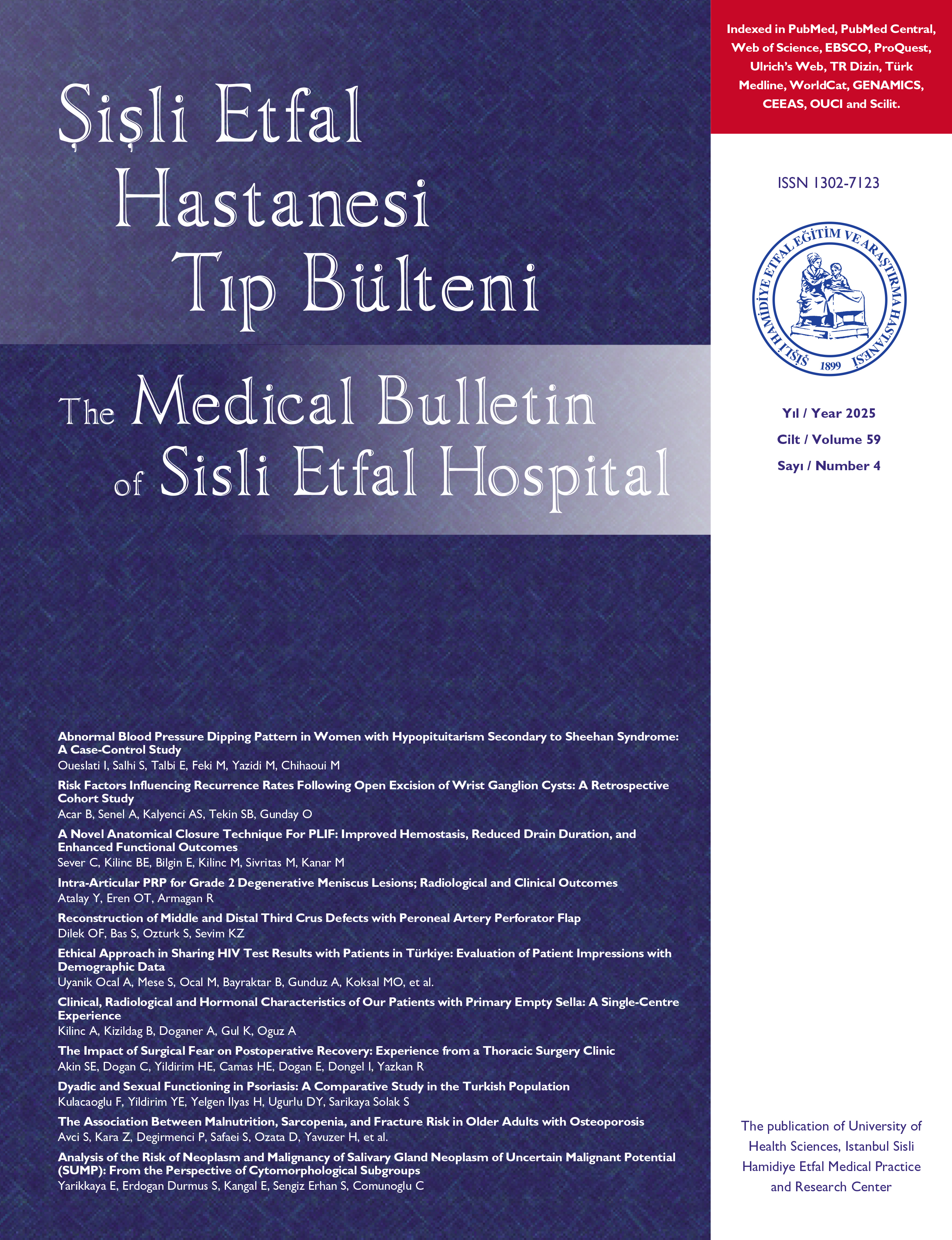
Recent Developments of Intraoperative Neuromonitoring in Thyroidectomy
Nurcihan Aygun1, Mehmet Kostek1, Adnan Isgor2, Mehmet Uludag11Department of General Surgery, University of Health Sciences, Sisli Hamidiye Etfal Training and Research Hospital, Istanbul, Turkey2Department of General Surgery, Bahcesehir University Faculty of Medicine, Istanbul; Sisli Memorial Hospital, Istanbul, Turkey
At present, intraoperative neuromonitorization (IONM) with surface electrode-based endotracheal tube (ETT) is a standard method in thyroidectomy and can be performed either intermittently IONM (I-IONM) or continuously IONM (C-IONM). Despite the valuable contribution of I-IONM to the thyroidectomy, it still has limitations regarding the recording electrodes and stimulation probe. New approaches for overcoming the limitations of I-IONM and developing the method are taking attention. Most of the technical issues of IONM with surface electrode-based ETT are related with inadequate contact of electrodes to the vocal cords. Nowadays, efficiency of various recording electrodes is under investigation. Recording electrodes such as needle electrodes applied to thyroarytenoid or posterior cricoarytenoid muscle (PCA), surface electrodes applied to the PCA, and needle or adhesive electrodes applied to the tracheal cartilage or skin, can make safe recordings similar to the ETT electrodes. Despite their invasiveness, needle electrodes record higher electromyography (EMG) amplitudes than tube electrodes do. Adhesive surface electrodes make safe EMG recordings, although amplitudes of these electrodes are usually lower than those of the tube electrodes. These different types of electrodes are less affected by tracheal manipulations and amplitude changes are lower compared to the tube electrodes.
During C-IONM, an additional stimulation probe is applied to the vagus nerve after dissecting the nerve circumferentially. Recently, without applying a probe, a new continuous monitorization method called laryngeal adductor reflex CIONM (LAR-CIONM) using sensorial, central, and motor components of LAR arch which is an automatic, primitive brainstem reflex protecting the tracheoesophageal tree from foreign body aspiration, has been implemented. Afferent track of LAR communicates laryngeal mucosa to the brainstem by internal branch of the superior laryngeal nerve and efferent track reaches larynx through recurrent laryngeal nerve. Total outcome of LAR activation is the closure of laryngeal entry by bilateral vocal cord adduction. In LAR-CIONM, a stimulus is given by an electrode from one side of surface electrode-based ETT and amplitude response of the LAR at the vocal cord is followed on the operation side. Recently, it has been reported that real-time EMG response can be obtained with stimulation probe cables applied to dissectors or energy devices during the dissection through I-IONM.
Keywords: Electromyography, neuromonitorization; recurrent laryngeal nerve; superior laryngeal nerve.
Recent Developments of Intraoperative Neuromonitoring in Thyroidectomy
Nurcihan Aygun1, Mehmet Kostek1, Adnan Isgor2, Mehmet Uludag11Sağlık Bilimleri Üniversitesi Şişli Hamidiye Etfal Eğitim ve Araştırma Hastanesi Genel Cerrahi Anabilim Dalı, İstanbul2Bahçeşehir Üniversitesi Tıp Fakültesi Genel Cerrahi Anabilim Dalı, İstanbul; Şişli Memorial Hastanesi, İstanbul
Günümüzde tiroidektomide yüzey elektrotlu endotrakeal tüp ile intraoperatif sinir monitorizasyonu (IONM) standart yöntem olup, aralıklı (I-IONM) veya sürekli IONM (C-IONM) şeklinde uygulanabilmektedir. I-IONMnin tiroidektomiye olan değerli katkısına rağmen kayıt elektrotları veya uyarı probu ile ilgili bazı sınırlılıkları bulnmaktadır. IONMnin sınırlılıklarını aşabilmak ve yöntemi geliştirmek için yeni yaklaşımlar dikkat çekmektedir. Yüzey elektrotlu endotrakeal tüp ile IONMde teknik problemlerin büyük bölümü, tüp elektrotlarının vokal kordlara uygun temas etmemesi ile ilgilidir. Günümüzde farklı kayıt elektrotlarının etkinliği araştırılmaktadır. Bu kayıt elektrotları tiroaritenoid veya posterior krikoaritenoid kasa uygulanan iğne elektrotlar, posterior krikoaritenoid kas yüzey elektrotları, trakeal kartilaja uygulanan iğne veya adheziv yüzey elektrotlar ve cilde uygulanan adesiv veya iğne elektrotlar gibi farklı tipte olup, bunlar da endotrakeal tüp elektrotları gibi güvenli EMG kaydı yapabilmektedirler. İğne elektrotları invaziv olmasına rağmen tüp elektrotlardan daha yüksek EMG amplitüdü kaydederler. Adheziv yüzey elektrotları ile amplitüd değerleri genelde tüp elektrottan daha düşük olmakla birlikte güvenilir EMG kaydı yapılabilmektedir. Bu farklı tip elektrotlar tüp elektrotlara göre trakeal manipülasyondan daha az etkilenmekte ve amplitüd değişimleri daha azdır.
C-IONMde vagus çepeçevre diseke edilerek vagusa ek bir uyarı probu uygulanmaktadır. Son zamanlarda vagusa prob uygulamadan trakeabronşial ağacı yabancı cisimlerin aspirasyonundan koruyan istemsiz, primitive bir beyin sapı refleksi olan laringeal adductor reflex (LAR) arkının duyu, merkezi ve motor bileşenlerini kullanan sürekli monitorizasyon yöntemi olan sürekli LAR-CIONM yöntemi klinik olarak uygulanmaya başlanmıştır. LARın afferent yolu superior laringeal sinirin internal dalı ile laryngeal mukozadan beyin sapına ulaşıp, eferent yolu RLN yoluyla larinkse ulaşmaktadır. LAR aktivasyonunun toplam sonucu bilateral vokal kord adduksiyonu ile laringeal girişin kapanmasıdır. LAR-CIONMde yüzey elektrotlu endotrakeal tüpün bir tarafındaki elektrottan uyarı verilerek, LARın operasyon tarafındaki vokal kordun amplitude cevabı takip edilmektedir. Son zamanlarda disektör veya enerji cihazlarına uygulanan uyarı probu kabloları ile I-IONM ile diseksiyon sırasında gerçek zamanlı EMG cevabı sağlanabileceği bildirilmiştir. (SETB-2021-08-236)
Anahtar Kelimeler: Rekürren laringeal sinir, süperior laringeal sinir, nöromonitörizasyon, EMG
Manuscript Language: English



















